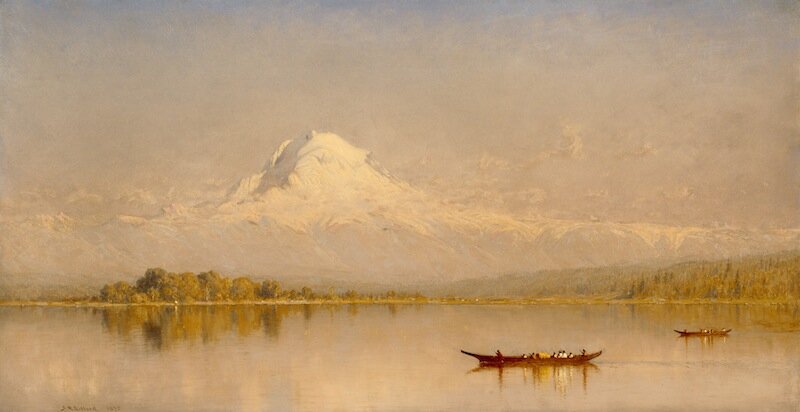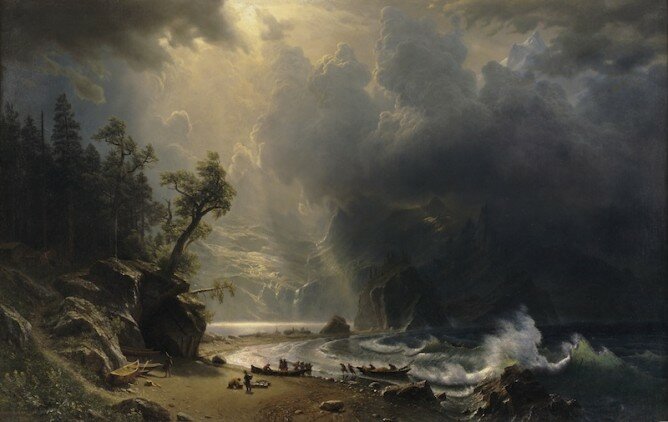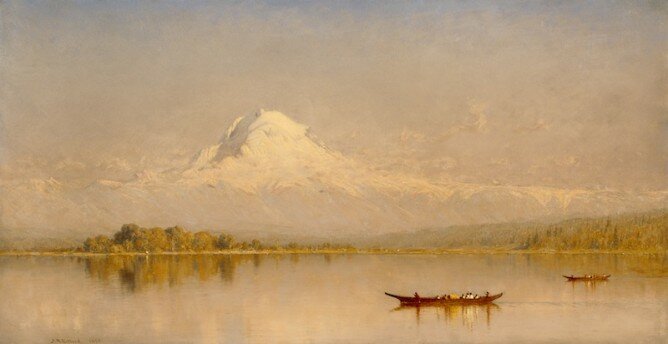Beauty and Bounty is the title of Seattle Art Museum’s summer exhibit, running through September 11. (It’s also the title of KCTS’s related documentary.) This is art from an age of American exploration, when our early-warning artists twigged to the public interest in what sights the frontier held, and to the fragility of what feels like raw wilderness.
SAM’s Derrick Cartwright mentioned the “enormous physical beauty” that drew artists out on endurance expeditions, hauling supplies out where there were no roads. Patricia Junker, the exhibit’s curator, sees this artistic representation of the natural commonwealth as the instigation of an early environmentalism–people fell in love with landscapes and wanted to preserve them.
Using the most immersive technology of the time–you might “watch” a painting as if it were a single-frame movie, in a darkened room, a curtain drawn when it was time to view–visitors had the chance to travel without leaving home. Now, you have the chance to time travel without mucking up the continuum. If it ever gets warm enough this summer to justify it, SAM’s air-conditioned outdoors-Americana will be a hot ticket.
The exhibition features some 150 paintings from the 19th and 20th centuries, with perhaps 45 cajoled from private collections by Junker that haven’t been seen in public exhibition before, or rarely. Along with the paintings come a trove of landscape photography, including large plate images by Carleton Watkins, Edward Muybridge, and Timothy O’Sullivan. (Most fun is the collection of stereo photographs that present long-ago scenes in 3D. SAM supplies viewers.)
The exhibit is a chance for SAM to show off Albert Bierstadt’s Puget Sound on the Pacific Coast, from 1870. Though Bierstadt (which, if my limited German doesn’t fail me, translates as the enchanting “Beer State”) traveled “through Oregon and up the coast of the Washington Territory” in 1863, as Junker has confirmed, he was also deeply addicted to the theatrical, and so his painting of the coast looks a little like Forks during the Puffy Cloud Apocalypse.
SIDEBAR #1: The clouds in Bierstadt’s painting particularly bothered me, but I am not a meteorologist. That’s why I asked University of Washington meteorologist Cliff Mass to weigh in on the clouds’ credibility.
Cliff writes: “Bierstadt’s picture is certainly dramatic, and the clouds ominous, but the form of the clouds do not look realistic to my eyes. For example, at places the cumulus turrets become wider as they rise–the opposite would be expected. There are no suggestions of mountain wave clouds, usually associated with lens-shaped lenticular clouds, something that is often seen in our region. There is too much of a correspondence of clouds with every major terrain feature and the terrain in the background seems far too high (looks like Mt. Everest). And finally the cloud base seems too uniformly dark. So the picture might not look right from a meteorological perspective, but it is interesting to look at.”
SIDEBAR #2: If you work at Google, you may know Bierstadt’s Emerald Sea, which Google VP of product management Bradley Horowitz commissioned art students to paint a copy of on the fourth floor of Building 2000 on the Google campus. As Ars Technica has it, it’s a “frightening mash up of a J.M.W. Turner painting and a storyboard for a scene from The Perfect Storm.” Horowitz saw in it the wave of social networking (Emerald Sea was the code name for Google+) bearing down on Google: “a possible tsunami poised to engulf it, or a maverick surge that it will ride to glory.”
With that in mind, you may want to revisit his Puget Sound scene, which also features waves bearing down on a pair of slight Native American canoes. A moment in the sun is about to vanish. (Listen to a 19th-century commenter describe the work here.)
As a modern-day response–“if we knew then what we know now”–SAM has also assembled Reclaimed: Nature and Place Through Contemporary Eyes. These are 45 works from artists who, in the majority, have worked in the Northwest: Robert Adams, Michael Brophy, Steven Davis, Eli Hansen, and Victoria Haven, to mention an alphabetical-through-H sampling.
Curator Marisa Sánchez writes: “Through the works in this exhibition, all made after 1970—a century after Albert Bierstadt’s Puget Sound on the Pacific Coast—we are reminded that nature is an active subject and a construct that reflects the desires and ambitions of the people who populate the land at a given time and place.”
Steve Davis‘s photograph Summer on the Skokomish captures riverside sunbathers in Déjeuner sur l’herbe repose while smoke from a forest fire rises–it might look somehow allegorical, but in fact the photographer is well aware that a forest fire can help clear out underbrush. Whiting Tennis‘s Bovine looks mostly like a pickup camper on blocks; fashioned out of plywood, it’s 14 feet long, and “references Western migration” while Hank Williams’ Alone & Forsaken plays (very quietly) inside.











I was there and believe I saw this it is awesome